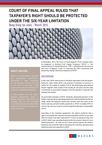
March 2015 - Court of final appeal ruled that taxpayer's right should be protected under the six-year limitation
Taxpayer's right under the 6-year limitation
BACKGROUND
In this case, AFSC entered into a franchise agreement with the Airport Authority under which AFSC was granted a franchise to construct a facility for the supply of aviation fuel at the Hong Kong International Airport together with a lease of the facility for 20 years and the right to nominate its associated company to be the operator to operate and maintain the facility.
An associated company of AFSC, being the nominated operator of the facility, entered into an operating agreement with the Airport Authority under which the operator would earn income from the users of the facility and pay periodic facility payments to AFSC to enable AFSC to recover the costs incurred in constructing the facility plus a reasonable return.
According to the franchise agreement, the Airport Authority had a right to terminate the franchise and lease granted to AFSC on any date after the airport has been operated for 5 years by paying a lump sum to AFSC which was calculated based on the net present value of future facility payments. As soon as the 5-year period expired, the Airport Authority exercised the right to terminate the franchise and lease and made the lump sum payment to AFSC.
Issue In Dispute
AFSC claimed that the lump sum was a payment by the Airport Authority to acquire its business and hence, was a capital receipt for the surrender of its business and non-taxable under Section 14 of the Inland Revenue Ordinance (“IRO”).
The Inland Revenue Department (“IRD”) however assessed the lump sum received by AFSC from the Airport Authority on the basis that the sum could be regarded as a substitute of the facility payments and therefore, be taxable as income under Section 14 of the IRO or alternatively under Sections 15(1)(m) and 15A of the IRO(1) as consideration for the transfer of a right to receive income from property.
DECISIONS OF LOWER COURTS
AFSC applied to the Court of First Instance (“CFI”) for the non-taxable claim of the lump sum from the Airport Authority. The CFI in 2011 ruled in AFSC’s favour that the lump sum from the Airport Authority could not be regarded as deriving from AFSC’s business and even if it was derived from the business, it was a capital receipt for the surrender of its business and hence, non-taxable under Section 14 of the IRO. The CFI also stated that AFSC did not transfer the right to receive income from property to the Airport Authority and even if it was concluded that there was a transfer of right to receive income, the legal or equitable interest in the property would be transferred to the Airport Authority along with the right to receive income and Sections 15(1) (m) and 15A were not applicable. The CIR appealed to the Court of CoA which also ruled in favour of AFSC in December 2012.
In the CoA, in addition of the revenue nature of the payments, the CIR also sought to raise the issue of whether balancing charge should be brought into account in respect of the facility.
The CoA ruled that the sum was not earned from the carrying on of business but arose outside the course of business activity. It was not a substitute or compensation for loss of the facility payments. There was no transfer of right to receive income from business to the Airport Authority from AFSC.
Furthermore, since there had been a succession of business by the Airport Authority and the facility had been passed by way of succession, a balancing charge could not be made under Sections 39B(7) and 39D(3) of the IRO(2).
The CoA exercised its discretion to consider the balancing charge issue despite the procedural objection of the taxpayer on the following grounds:
(a) The CIR was not seeking to make new assessment on a different or wider basis than the assessment under objection; and
(b) No unfairness in procedures would be suffered by AFSC since it could still object to any additional assessment made on account of balancing charge.
DECISION OF THE COURT OF FINAL APPEAL
The CIR surrendered his argument that the sum received by AFSC was taxable under Section 14 or Sections 15(1) (m) and 15A. The CIR only applied for leave to appeal to the CFA on whether balancing charge should be imposed on AFSC on the sale of assets. He had raised two questions for the CFA:
(1) whether, for the purpose of imposing a balancing charge on the sale of plant and machinery giving rise to the sale moneys, the imposition of a balancing charge is avoided by virtue of Section 39D in circumstances where the assets pass by way of succession by reason of sale; and
(2) whether the “succession defence” in Section 39D(3) is available against a charge on proceeds of sale of prescribed fixed assets under Section 16G(3) and, a balancing charge on the sale of industrial buildings under Section 35(1) (a) giving rise to the sale moneys.
The CIR considered that there was a clear finding in the CoA’s judgment that there was a sale of the business of AFSC, including the facility (being the plant and machinery, prescribed fixed assets and industrial buildings for the purpose of the balancing charge).
The CIR argued that the CoA was wrong to hold that a balancing charge would not be made by the “succession” defence of AFSC by virtue of Sections 39B(7) and 39D(3). Sections 39B (7) and 39D (3) only apply to a succession to a trade otherwise than by the sale of the relevant plant and machinery. In addition, Section 39D(3) does not apply to a charge on proceeds of sale of prescribed fixed assets under Section 16G(3) or a balancing charge on the sale of industrial buildings or structures under Section 35(1)(a) giving rise to the sale moneys.
Should CoA Entertain The Balancing Charge Submission?
The CFA considered the important question for them to decide is whether the CIR should have been allowed to raise the question of balancing charge at the last minute before the hearing in the CoA.
The CFA considered that although a revised assessment under Section 67(7) of the IRO was not limited by the 6-year statutory limit, the CoA should have the jurisdiction to entertain the CIR’s submission that AFSC should be subject to tax on the balancing charge only if the CIR had acted fairly.
The CFA held that it would be unfair to deprive AFSC of the protection of the normal 6-year limitation period as the issue of balancing charge would require further investigation of facts as to what part of the lump sum from the Airport Authority should be attributable to the various assets that have attracted tax depreciation allowances and deductions. Based on the above, the CFA ruled that CoA should not have entertained the CIR’s submission that balancing charge should be made and dismissed the CIR’s appeal.
Any Balancing Charge?
As the CFA dismissed the CIR’s appeal, it was not necessary for the CFA to decide whether the lump sum from the Airport Authority attracted balancing charge.
However, the CFA did express its views on the merits of the CoA’s decision on the issue of balancing charge at the request of the CIR.
The CFA was of the view that there in fact had been a sale of the relevant plant and machinery by AFSC to the Airport Authority in the course of the succession of the business. Therefore, Sections 39B (7) and 39D(3) of the IRO were not applicable. Even if Sections 39B(7) and 39D(3) applied, they would only be relevant to the claw back of depreciation allowances on plant and machinery, not other allowances such as industrial/commercial building allowance or prescribed fixed assets. In other words, balancing charge could arise for industrial/ commercial building structures and prescribed fixed assets even if they were passed to the Airport Authority by succession other than by sale.
COMMENTS
According to the CFA’s decision, the CIR must act fairly when exercising his power to make assessments even if he is not statute-barred to do so. The taxpayers’ rights should be protected by the 6-year limitation period. It is well established that a “statement of loss” is not a “notice of assessment” and therefore the IRD is not statute-barred to revise such a statement after the 6-year limitation period. Undue burden has been rested on taxpayers to keep records of loss years beyond the statutory minimum retention period of 7 years.
CFA’s comments on the CIR’s duty should equally apply to tax loss cases. Whether this case has any impact on the IRD’s attitude towards loss cases beyond the statutory limitation period is yet to be seen.
(1) Pursuant to Sections 15(1)(m) and 15A of the IRO, where a right to receive chargeable income from property is transferred by one person to another person, the consideration received for such a transfer is deemed to be taxable receipt except if the transfer of to receive income takes place together with a transfer of the legal or equitable estate or interest in the property.
(2) Sections 39B(7) and 39D(3) of the IRO provide that a balancing charge or balancing allowance should not be applicable in the case where the plant and machinery are passed by way of succession other than by sale upon cessation of a trade or business.

